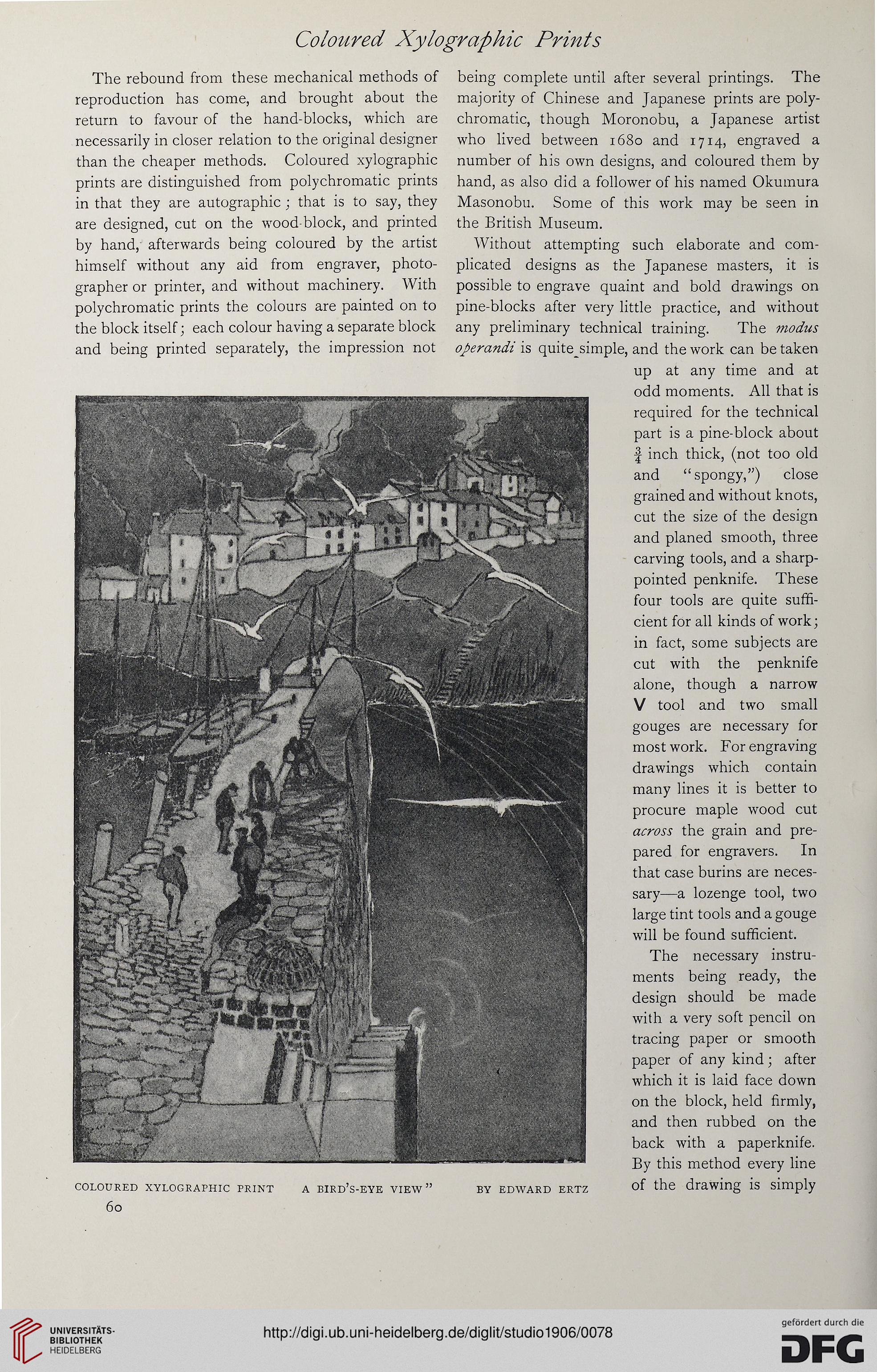Coloured Xylographic Prints
being complete until after several printings. The
majority of Chinese and Japanese prints are poly-
chromatic, though Moronobu, a Japanese artist
who lived between 1680 and 1714, engraved a
number of his own designs, and coloured them by
hand, as also did a follower of his named Okumura
Masonobu. Some of this work may be seen in
the British Museum.
Without attempting such elaborate and com-
plicated designs as the Japanese masters, it is
possible to engrave quaint and bold drawings on
pine-blocks after very little practice, and without
any preliminary technical training. The modus
operandi is quite^simple, and the work can be taken
up at any time and at
odd moments. All that is
required for the technical
part is a pine-block about
| inch thick, (not too old
and “spongy,”) close
grained and without knots,
cut the size of the design
and planed smooth, three
carving tools, and a sharp-
pointed penknife. These
four tools are quite suffi-
cient for all kinds of work;
in fact, some subjects are
cut with the penknife
alone, though a narrow
V tool and two small
gouges are necessary for
most work. For engraving
drawings which contain
many lines it is better to
procure maple wood cut
across the grain and pre-
pared for engravers. In
that case burins are neces-
sary—a lozenge tool, two
large tint tools and a gouge
will be found sufficient.
The necessary instru-
ments being ready, the
design should be made
with a very soft pencil on
tracing paper or smooth
paper of any kind; after
which it is laid face down
on the block, held firmly,
and then rubbed on the
back with a paperknife.
By this method every line
coloured xylographic print a bird’s-eye view” by edward ertz of the drawing is simply
60
The rebound from these mechanical methods of
reproduction has come, and brought about the
return to favour of the hand-blocks, which are
necessarily in closer relation to the original designer
than the cheaper methods. Coloured xylographic
prints are distinguished from polychromatic prints
in that they are autographic ; that is to say, they
are designed, cut on the wood block, and printed
by hand, afterwards being coloured by the artist
himself without any aid from engraver, photo-
grapher or printer, and without machinery. With
polychromatic prints the colours are painted on to
the block itself; each colour having a separate block
and being printed separately, the impression not
being complete until after several printings. The
majority of Chinese and Japanese prints are poly-
chromatic, though Moronobu, a Japanese artist
who lived between 1680 and 1714, engraved a
number of his own designs, and coloured them by
hand, as also did a follower of his named Okumura
Masonobu. Some of this work may be seen in
the British Museum.
Without attempting such elaborate and com-
plicated designs as the Japanese masters, it is
possible to engrave quaint and bold drawings on
pine-blocks after very little practice, and without
any preliminary technical training. The modus
operandi is quite^simple, and the work can be taken
up at any time and at
odd moments. All that is
required for the technical
part is a pine-block about
| inch thick, (not too old
and “spongy,”) close
grained and without knots,
cut the size of the design
and planed smooth, three
carving tools, and a sharp-
pointed penknife. These
four tools are quite suffi-
cient for all kinds of work;
in fact, some subjects are
cut with the penknife
alone, though a narrow
V tool and two small
gouges are necessary for
most work. For engraving
drawings which contain
many lines it is better to
procure maple wood cut
across the grain and pre-
pared for engravers. In
that case burins are neces-
sary—a lozenge tool, two
large tint tools and a gouge
will be found sufficient.
The necessary instru-
ments being ready, the
design should be made
with a very soft pencil on
tracing paper or smooth
paper of any kind; after
which it is laid face down
on the block, held firmly,
and then rubbed on the
back with a paperknife.
By this method every line
coloured xylographic print a bird’s-eye view” by edward ertz of the drawing is simply
60
The rebound from these mechanical methods of
reproduction has come, and brought about the
return to favour of the hand-blocks, which are
necessarily in closer relation to the original designer
than the cheaper methods. Coloured xylographic
prints are distinguished from polychromatic prints
in that they are autographic ; that is to say, they
are designed, cut on the wood block, and printed
by hand, afterwards being coloured by the artist
himself without any aid from engraver, photo-
grapher or printer, and without machinery. With
polychromatic prints the colours are painted on to
the block itself; each colour having a separate block
and being printed separately, the impression not




